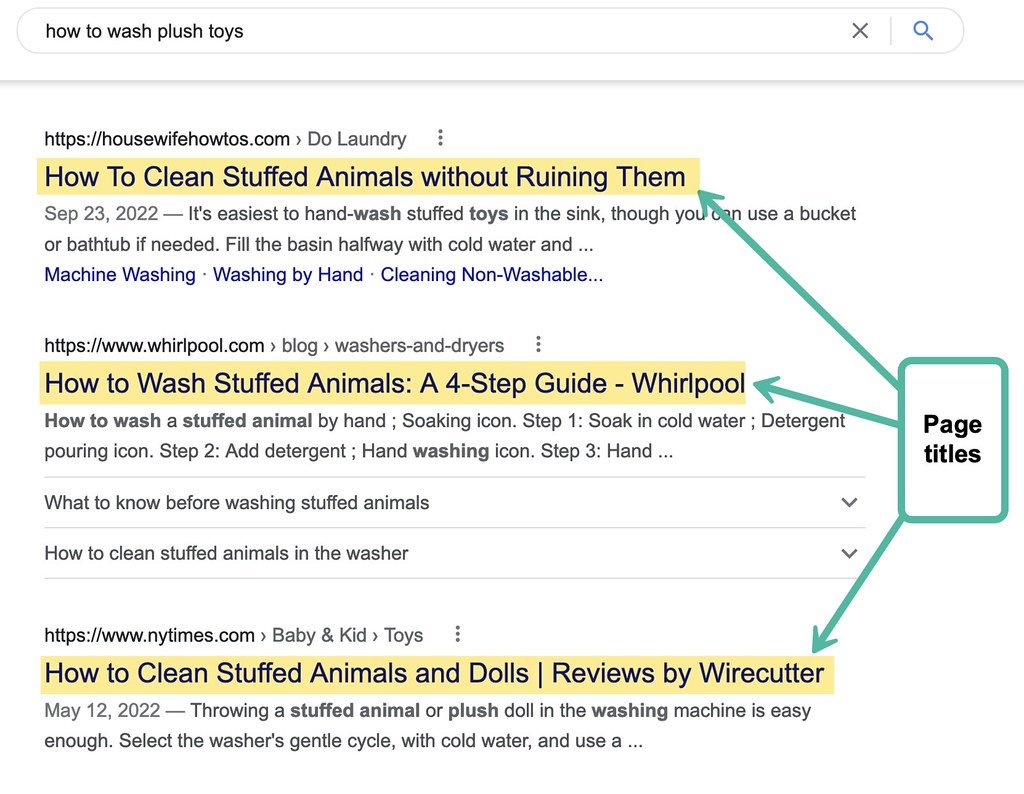Crafting a perfect headline is arguably the most difficult part of content creation. After all, this is the very first piece of text your audience will encounter before they even get to the nitty gritty of the article.
Did you know that a whopping 80% of people will only read article titles while only 20% will take the time to read the rest?
You don’t want to spend valuable time and energy creating an article only to have it dismissed by your potential audience, do you? Of course not!
Let’s look at some valuable components to crafting content titles so that your hard work is noticed.

Table of Contents
Making Your Beginning Perfect
Nailing the start of your blog posts begins with crafting the perfect headline. A great headline grabs attention and sets the tone for what’s to come.
It should be clear, catchy, and compelling—think of it as a promise to your readers. Make sure it gives a hint of the blog’s value, so readers know exactly what they’ll get.
Use strong, active words to create a sense of urgency or excitement. Keep it short and sweet; aim for no more than 8 to 12 words.
Remember, your headline is your first impression, so make it count.
1. Make Your Headline SEO Friendly
Search Engine Optimization (SEO) drives content visibility like nothing else. And, boy, we all want our content to go places!
First and foremost, include keywords in the title. Ask yourself, when someone types words into a search query about the topic I’m writing about, which keywords they may be using to find that information?
A searchable keyword should always be in your content title. It should also be sprinkled (not stuffed) throughout the body of your article. Plan on your article being easily searchable long after publication for the maximum amount of views. Keep in mind that an awesome title is worth sharing.
SE Ranking offers one of the most useful keyword suggestions tools out there: I just love the usability of the tool that saves tons of time.
You can filter search queries by difficulty to find keywords that are easier to rank for:

Traditionally, Google would show your page title as the most prominent part of your search snippet. As of recently, Google has been changing titles when creating search snippets.
To avoid that, make sure your title is used as the headline of your article, and it is the first thing people see when landing on your page.

Most WordPress themes will take care of this (here’s an example of typography).

Notice how most of those titles in the screenshots include brand names. This is generally a good idea helping you build some brand recognizability over time.
2. Analyze What Works
When writing content titles, it is best practice to perform content analysis to determine whether or not your content is successful.
- Keep track of which titles stand out to your audience. You can determine this by monitoring how many page views your content is receiving, how much time someone spends on the page, as well as the bounce rate.
- Find out what is driving success. Different topics generate different levels of success. Additionally, posting content on different days of the week can also determine how well an article performs online. Perhaps certain keywords are what triggers more page views and shares.
- Analyze your competitor’s titles. Although you have no way of knowing their metrics, you can take a look at their social media sharing buttons to give you an idea of how effective their content is. Copying is a crime, but adapting is creative.
WebCEO is a SEO tool that offers a handy Content Assistant tool allowing you to analyze how your competitors are using SEO to optimize their titles and how that works for them.
It is a great way to learn from your competitors without copying their tactics:

3. Write Titles for More Than One Audience
Naturally, the first audience you write for is your readers. This is the audience that sees your title and is affected in one way or another by it.
However, this is also the audience that clicks through your content if they are intrigued. Traditionally, writers will direct their content titles at this particular audience, but other audiences play a vital role in giving articles authority.
Another audience to direct content for is social media shares. This audience doesn’t actually read content but is constantly on the lookout for compelling information to select, organize, and present to social followers.
The last audience is search engines. Search engines rank the relevance of your content to respond to specific search queries.
4. Ask The Right Question in Perfect Headline
You’ll notice that all of these headline ideas work best when combined with the other ones. That’s especially true with the question headlines.
Questions only work when they evoke emotions and curiosity.
- It has to be important to your readers. For example “Does Your Dog Pee on Your Sofa?” won’t interest people who only have goldfishes.
- It has to provoke emotions. For example “Is Your Daughter Aware of These Dangers in College?” will catch the attention of parents.
- It has to feel important. For example “Are You Making these Basic Mistakes in Your Copy?” may make your audience think, “no” and they won’t read more.
And most importantly, it has to make an implied promise about the value the reader will get from reading forward.
5. Poke Them Where It Hurts
[Yes, it sounds harsh, but it is actually about solving problems your audience has…]
If in doubt, make a promise.
That works in copywriting. It works in blogging. It works with X Twitter. It works everywhere.
The purpose of the headline is always to make a promise, even when it’s not direct. But a direct promise is the easiest way to write a headline that works.
Just think of something that’s really important for your audience and promise to deliver it.
This is a relatively easy headline to write; yet it’s very effective.
There are two steps to writing this kind of a headline:
- Identify your audience’s common insecurity. Asking your audience directly to identify those insecurities is a good way. Using conversational forms for that is the best way to engage your audience and let them help you with headline ideas.
- Rub it in their faces with the headline.
Let’s say your site is about gardening. Maybe your audience shares insecurity about what their neighbors think about your readers’ gardens.
So, here’s what the headline could be: “7 Ways to Make Your Neighbors Stop Laughing at Your Garden”.
For struggling businesses, your headline can be as simple as “You’re Losing Customers”. That will get their attention.
If you hit a nerve – which you should – they can’t help but read on.
Just be aware that if the topic is too sensitive, this tactic may backfire, so don’t overdo…. So, “How to stop gaining weight, so people won’t think you’re a pig anymore” would probably turn most readers off.
Don’t be cruel…
Also, don’t just come up with this type of title for the clickbait purposes. If you make a promise, make sure your content delivers the solution. Avoid making empty promises.
6. Be Different for Crafting Perfect Headlines
People are bombarded with messages – advertising, emails, tweets, and newspapers – all the time.
There are so many messages that you can’t pay attention to all of them.
Only somehow surprising headlines still manage to capture attention.
And you’ll get more attention if your headline is really weird.
For example “How to Seduce a Goldfish” is weird enough to attract attention. [Yes, it is an actual article to seduce a goldfish. I know you got curious…]
Really weird headlines are not necessarily the best headlines (and they are also hard to make SEO friendly), but if you can add a weird twist to your headline, it often performs better.
Conclusion: Feeling Writer’s Block For Best Headlines
It is completely natural to feel writer’s block when creating a perfect headline. Especially knowing that this is the most vital component to your entire article.
Talk about pressure! Perhaps the first question you tend to ask yourself is, “how much time should I spend writing my title?” After all, it’s only 6-10 words, so it should take no more than fifteen minutes, right?
Wrong. Spend as much time as needed. Actually, sleep on it.
Do you find yourself struggling to come up with a title for your article? There are numerous tools that formulate lists upon lists of options once you feed it a little information.
Title Generator is a tool that is handy and incredibly easy to use. All you have to do is come up with a focus keyword and Title Generator does the rest.
The first page alone of generated titles had 300 suggestions and there were still two more pages to sort through. Some title generators produce tacky titles, but these suggestions are worthy of your attention.
Don’t forget about your meta title descriptions as well.
Don’t just copy and use any of the generated titles though. These generators exist to give you some inspiration which is all we, writers, need.
- Why Live Streaming? How to Start to Grow Your Authority - July 23, 2025
- ChatGPT AI Writer: 6 Ways To Update & Repackage Old Content - June 18, 2025
- Craft the Perfect Headline: Your Content Deserves It - August 16, 2024




Creating the perfect headline is crucial because it’s often the first thing that grabs a reader’s attention. A well-crafted headline not only draws readers in but also sets the tone for the entire piece. If you’re struggling to find the right words, online ghostwriting services can be a great resource. Professional ghostwriters can help you craft compelling, attention-grabbing headlines that resonate with your target audience and enhance the overall impact of your content. After all, your content deserves the best chance to shine!
Hi Jack, welcome to Inspire To Thrive. Oh yes ghostwriters and AI tools are great for helping people craft the best headlines. Thanks for your input and have a great day Jack.
I definitely agree that thinking of a good headline is one of the hardest parts of writing! In fact, for me it’s perhaps the hardest part. Short and punchy titles just don’t come easily to me, never mind when it’s for the internet and I need to take SEO into consideration. I started using the Advanced Marketing Institute Headline Analyzer and think that helps. Fortunately, on your own blog you can always change titles if you think of a better one or want to re-work the SEO, so at least a sub-par title doesn’t have to be a permanent thing!
It’s been so long since I wrote a weird title Ann lol. I was relating my travel experiences to blogging on and off for quite a long time with some colorful subjects. Me thinks it is time to hop back into the strategy here and there because it’s so much fun and seems to entertain our community. It definitely takes a willingness to put yourself out there and do something quite a bit different from most bloggers.
Excellent advice here.
Ryan
Thanks for stopping by to read, Ryan, it’s been a long time since we caught up!
Hi Ann & Lisa,
In content writing and marketing, crafting compelling headlines is half the battle to getting people to click and read your blog post. If you struggle to get your titles right, you won’t move people to click your article headline. So, you wasted time and energy writing informative content nobody wants to read. It’s just as though you never wrote anything at all.
Hence, I love the idea of “Analyzing what works.” You don’t reinvent the will, but follow what’s working or trending, tailor them to your advantage, and create better headlines. It’s that simple!
Moreover, it would help to study headlines that rank at the top of SERPs for your primary keyword. Determine what headlines rank: list titles, how-to headlines, complete/ultimate guide titles, and the like. Pinpoint what format is ranking and use it to strengthen your headline.
Thank you for sharing, Ann, and thank you, Lisa, for publishing this post!
Hi Moss, thanks for coming by on this fabulous article by Ann. Headlines can make a huge difference in your content. I know I have struggled with mine for years but have been getting better as time goes on. I look for power words as well. Have a great day Moss.
Great point on using competitive analysis to find some ideas. Thank you, Moss!
Great post. When creating headlines I try to appeal to both readers and the search engines at the same time. It’s a part of sounding natural, and it’s something that I’m gradually getting better at as I learn more about copywriting and SEO.
I know! That’s a tough balance to achieve as we need to make the titles both SEO-friendly and attention-grabbing! I’ve never seen a person who thinks it is easy though!